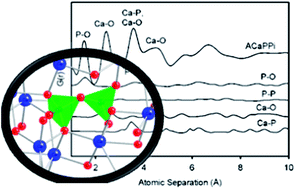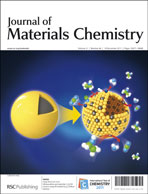There is increasing evidence that amorphous inorganic materials play a key role in biomineralisation in many organisms, however the inherent instability of synthetic analogues in the absence of the complex in vivo matrix limits their study and clinical exploitation. To address this, we report here an approach that enhances long-term stability to >1 year of biologically relevant amorphous metal phosphates, in the absence of any complex stabilisers, by utilising pyrophosphates (P2O74−); species themselves ubiquitous in vivo. Ambient temperature precipitation reactions were employed to synthesise amorphous Ca2P2O7.nH2O and Sr2P2O7.nH2O (3.8 < n < 4.2) and their stability and structure were investigated. Pair distribution functions (PDF) derived from synchrotron X-ray data indicated a lack of structural order beyond ∼8 Å in both phases, with this local order found to resemble crystalline analogues. Further studies, including 1H and 31P solid state NMR, suggest the unusually high stability of these purely inorganic amorphous phases is partly due to disorder in the P–O–P bond angles within the P2O7 units, which impede crystallization, and to water molecules, which are involved in H-bonds of various strengths within the structures and hamper the formation of an ordered network. In situ high temperature powder X-ray diffraction data indicated that the amorphous nature of both phases surprisingly persisted to ∼450 °C. Further NMR and TGA studies found that above ambient temperature some water molecules reacted with P2O7 anions, leading to the hydrolysis of some P–O–P linkages and the formation of HPO42− anions within the amorphous matrix. The latter anions then recombined into P2O7 ions at higher temperatures prior to crystallization. Together, these findings provide important new materials with unexplored potential for enzyme-assisted resorption and establish factors crucial to isolate further stable amorphous inorganic materials.

You have access to this article
 Please wait while we load your content...
Something went wrong. Try again?
Please wait while we load your content...
Something went wrong. Try again?


 Please wait while we load your content...
Please wait while we load your content...